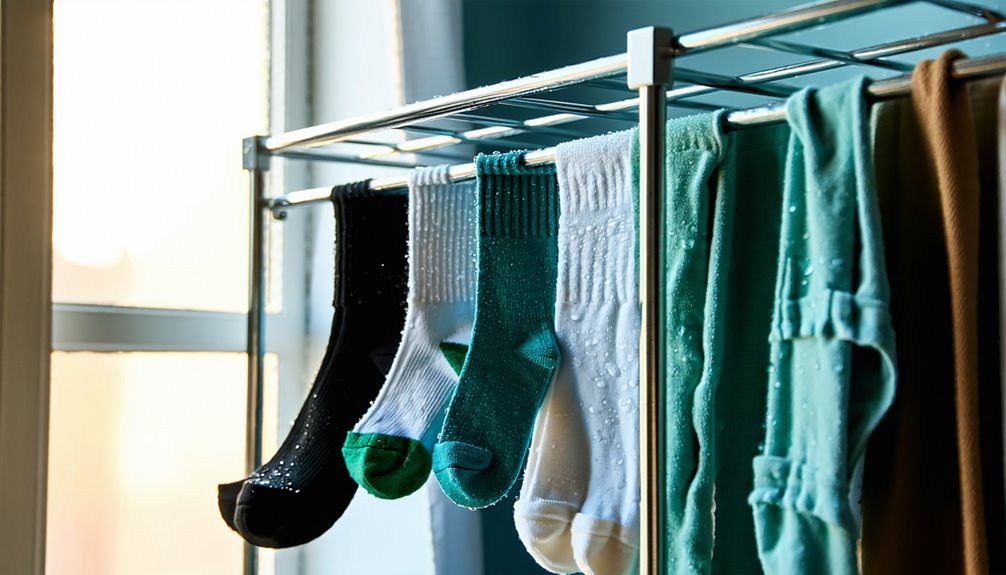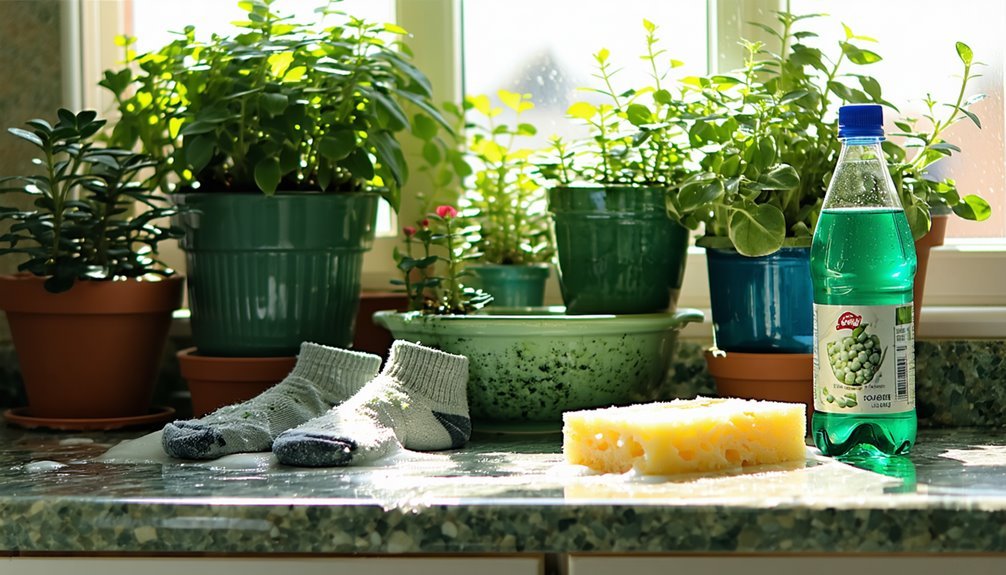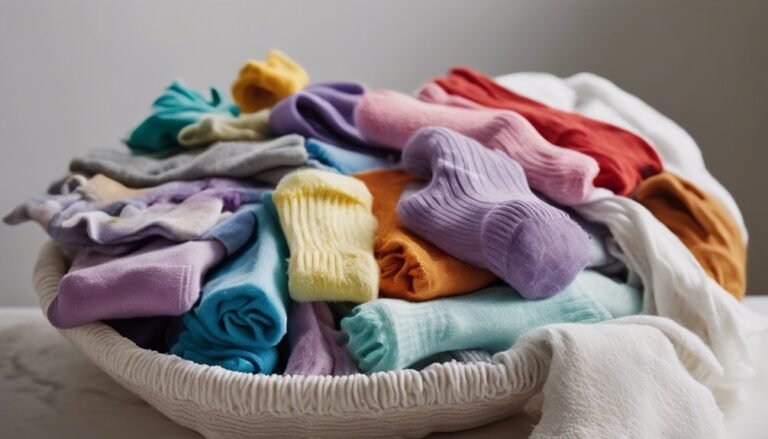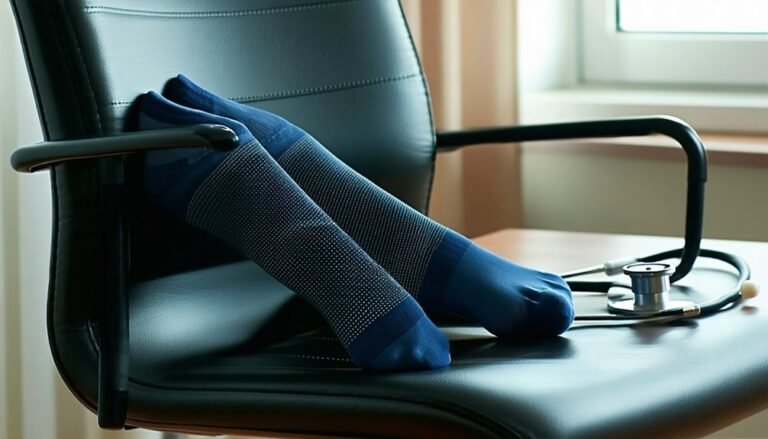How to Remove Mould From Socks
To remove mould from socks, first inspect them under good lighting for any discolouration. Prepare a solution using one part white vinegar mixed with four parts water and soak the socks for at least 30 minutes. Gently scrub the affected areas with a soft-bristled brush, then rinse thoroughly. Wash the socks in hot water with a mould-targeting detergent, and make certain they dry in a well-ventilated area to prevent future growth. You'll discover more effective techniques and tips for maintenance.
Understanding Mould and Its Causes

When you find mould on your socks, it's important to understand that this unwanted growth thrives in damp, warm environments. Mould biology reveals that these fungi reproduce through spores, which can easily spread in suitable conditions. Environmental factors such as humidity, temperature, and poor ventilation play vital roles in mould proliferation. High humidity levels, particularly above 60%, create the ideal breeding ground for mould. Additionally, warmth enhances its growth, making your socks a prime target if stored improperly. To prevent mould growth, verify your socks are dry before storage and keep them in a well-ventilated area. By controlling these environmental factors, you can greatly reduce the risk of mould infestation and maintain a safer, healthier living space.
Inspecting Your Socks
When inspecting your socks, start by checking for any visible mould growth on the fabric. Next, assess the type of material your socks are made from, as this can influence the cleaning method you'll need to use. Finally, determine the severity of the stain to tailor your approach effectively.
Check for Visible Mould
Before you begin the cleaning process, it's important to thoroughly inspect your socks for visible mould. Start by holding each sock up to a light source, examining for dark patches or fuzz, which indicates mould growth. Pay attention to seams and areas that may have been in contact with moisture during sock storage. If you spot any discolouration, it's necessary to address it before using mould removal techniques. Remember, even small amounts of mould can pose health risks, so don't overlook any signs. Once you've identified contaminated socks, separate them from the rest, ensuring safe handling to prevent cross-contamination. This careful inspection is significant for effective mould removal and maintaining your overall sock hygiene.
Assess Fabric Type
Understanding the fabric type of your socks is essential, as it influences the method you'll use for mould removal. Begin by checking the label for fabric characteristics—common materials include cotton, wool, and synthetic blends. Each fabric type has specific care requirements; for instance, cotton is generally more durable and can withstand higher temperatures, while wool requires gentler handling.
If your socks are made of delicate fabrics, avoid aggressive cleaning solutions that may damage the fibers. Knowing the fabric care recommendations will guide you in selecting appropriate cleaning agents and techniques. A careful assessment will not only guarantee effective mould removal but will also help maintain the integrity of your socks, keeping them safe for future wear.
Determine Stain Severity
How can you effectively determine the severity of mould stains on your socks? Start by inspecting each sock under good lighting. Look for discolouration, texture changes, and any signs of colour fading. If the mould appears as small spots, it may indicate a milder issue, while larger, darker patches often signify a more severe problem. Gently touch the stained areas to assess if they're still soft; stiffness can mean deeper penetration into the fabric. Consider the fabric type, as some materials are more susceptible to permanent damage. For effective stain removal, you'll need to match your cleaning method to the stain's severity and fabric type to avoid further damage. Always prioritize safety by wearing gloves during your inspection.
Preparing a Cleaning Solution
To effectively remove mould from your socks, you'll need to choose suitable ingredients for your cleaning solution. It's crucial to understand the correct mixing ratios to guarantee ideal results while also prioritizing your safety during the process. By following these guidelines, you'll create a powerful yet safe solution to tackle the mould effectively.
Choosing Suitable Ingredients
When it comes to effectively removing mould from your socks, selecting the right cleaning solution is essential for achieving ideal results. You can choose between natural cleaners and chemical solutions, depending on your preferences and safety concerns. For a safer option, consider using vinegar or baking soda, both of which possess natural antifungal properties. These ingredients are less likely to cause skin irritation and are environmentally friendly. If you prefer a chemical solution, opt for one that's specifically designed for mould removal, ensuring it's safe for fabrics. Always read labels and follow safety instructions carefully. Whichever route you take, be sure to test the solution on a small fabric section first to prevent any damage to your socks.
Mixing Ratios Explained
Getting the right mixing ratios is vital for effectively preparing a cleaning solution to remove mould from your socks. Start by determining the appropriate solution concentrations based on the cleaning agent you've chosen. For instance, if you're using vinegar, a common ratio is one part vinegar to four parts water. When employing baking soda or hydrogen peroxide, consult product guidelines to guarantee safety and effectiveness.
Use precise mixing techniques, like measuring with a graduated cylinder or measuring cup, to maintain accuracy. It's important to mix thoroughly, making sure the solution is homogenous before application. This attention to detail not only enhances cleaning efficacy but also minimizes any potential risks to your socks and your skin during the cleaning process.
Safety Precautions Needed
Guaranteeing safety is paramount while preparing your cleaning solution for mould removal. Different mould types can release spores that may irritate your skin, eyes, or respiratory system, so it's crucial to take precautions. Start by wearing protective gear, including gloves, masks, and goggles, to shield yourself from harmful exposure. Make sure you're in a well-ventilated area to minimize inhalation risks. When mixing your solution, always follow the recommended ratios, and never combine cleaning agents unless specified, as this can create toxic reactions. After preparing your solution, keep it out of reach of children and pets. By adhering to these safety measures, you can effectively tackle mould while protecting your health and well-being.
Soaking the Socks

Although mould can be stubborn, soaking your socks in a proper solution can greatly enhance your chances of removal. Using effective soaking techniques is essential, and you should consider the following steps for ideal results:
- Choose a Solution: Use a mixture of water and white vinegar or baking soda.
- Fill a Container: Submerge your socks in enough solution to cover them fully.
- Soaking Duration: Let the socks soak for at least 30 minutes, but you can extend this to a few hours for tough stains.
- Check Periodically: Inspect the socks during soaking to assess the mould's progress.
This method guarantees the solution penetrates fibers, aiding in mould removal while maintaining safety throughout the process.
Scrubbing Away the Mould
Once you've soaked your socks and the mould has softened, it's time to tackle the next step: scrubbing away the mould. Begin by wearing gloves to protect your skin during the mould removal process. Use a soft-bristled brush or an old toothbrush for effective cleaning techniques. Gently scrub the affected areas, applying a bit of pressure to dislodge the mould without damaging the fabric. If needed, dampen the brush with a mixture of water and mild detergent to enhance your cleaning efforts. Be thorough, ensuring you reach all crevices where mould may linger. After scrubbing, rinse the socks under running water to wash away any loosened mould and detergent residue, preparing them for the next phase of cleaning.
Washing the Socks
After you've thoroughly scrubbed your socks, it's important to wash them properly to eliminate any remaining mould spores. The right washing temperatures and techniques will guarantee your socks return to a safe state. Follow these steps for an effective clean:
- Check Sock Materials: Always read the care label to determine suitable washing temperatures.
- Use Hot Water: For cotton and synthetic blends, a hot wash (at least 60°C/140°F) is effective against mould.
- Select the Right Detergent: Use a detergent that targets mould and mildew for best results.
- Rinse Thoroughly: Confirm all detergent is rinsed out to avoid skin irritation.
Drying Techniques to Prevent Mould

To guarantee your socks remain mould-free, using effective drying techniques is essential, especially when dealing with moisture-prone fabrics. Here are some recommended drying methods that emphasize moisture control:
| Drying Method | Description |
|---|---|
| Air Drying | Hang your socks in a well-ventilated area. |
| Tumble Drying | Use a low-heat setting to avoid fabric damage. |
| Sun Drying | Utilize sunlight, which has natural mould-fighting properties. |
| Dehumidifier | Employ a dehumidifier in damp environments to enhance airflow. |
Tips for Future Mould Prevention
Maintaining a mould-free environment for your socks goes beyond effective drying techniques. To guarantee your socks remain in pristine condition, consider these tips for future mould prevention:
- Choose Mould Resistant Fabrics: Opt for socks made from synthetic fibres or treated materials that resist moisture absorption.
- Wash Regularly: Keep your socks clean by washing them frequently, especially after sweaty activities, to eliminate potential mould spores.
- Proper Storage: Store your socks in a cool, dry place. Avoid damp areas such as basements or bathrooms.
- Use Moisture Absorbers: Consider placing silica gel packets or activated charcoal in your storage area to absorb excess moisture.
Frequently Asked Questions
Can I Use Bleach to Remove Mould From Socks?
Using bleach to remove mould isn't always safe, as it can damage fabrics. Consider bleach alternatives like vinegar or baking soda. For the future, focus on mould prevention by keeping items dry and well-ventilated.
How Can I Tell if Mould Is Gone?
Ever wondered if your efforts were enough? To guarantee mould removal's complete, check for any discoloration, smell, or texture changes in your socks. Proper sock care means thorough washing and drying—keep them safe and fresh!
Is It Safe to Wear Mouldy Socks Once Cleaned?
Once cleaned, it's essential to guarantee mould safety. If you've thoroughly removed mould and stored socks properly, they should be safe to wear. However, always inspect for lingering spores before putting them on.
Can Mould on Socks Cause Health Issues?
Mould on socks can indeed lead to unwelcome health concerns. You might experience mould symptoms like irritation or respiratory issues, especially if your sock storage isn't ideal. It's best to prioritize cleanliness for your well-being.
What Materials Are Most Prone to Mould Growth?
Mould thrives in moist environments, particularly on fabric types like cotton and wool. These materials retain moisture, creating ideal conditions for mould growth. Regular washing and drying can help mitigate potential health risks associated with mould.






